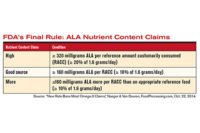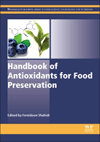Formulating dairy foods with omega-3s
Consumers are all for omega-3s, but many don’t consume the recommended daily amounts. Dairy products are an excellent delivery vehicle, but fortifying dairy foods with the fatty acids is challenging on many levels.


|
|
DHA has been used in foods in the United States since 2002. Horizon’s Organic Milk with DHA Omega-3 contains DHA from algal oil in the amount of 32 milligrams per 8 ounces. The milk is sold in half-gallons in whole, reduced-fat, low-fat or fat-free versions. Horizon Organic will introduce single-serve boxes this year. |
Consumers are hooked on omega-3 fatty acids. And they are likely to stay on the line as research supporting omega-3s’ health benefits continues to amass.
This trend has not escaped the attention of the dairy industry. Ever since omega-3s hit the health scene, ingredient suppliers and dairy processors have used research regarding omega-3 fortification to develop dairy products that offer consumers the omega-3s they’re fishing for. In the process, the dairy industry has obtained insights that will lead the way to additional product innovations.
Why fortify?
Omega-3s are long-chain, polyunsaturated fatty acids that include alpha-linolenic acid (ALA), eicosapentaenoic acid (EPA) and docosohexanoic acid (DHA). ALA is an essential fatty acid that can be converted by the body to EPA and DHA, but not in significant quantities.
Omega-3s have anti-inflammatory and anticoagulant properties and are important for health, particularly brain and eye development and heart health. But most people don’t consume adequate amounts of omega-3s, especially EPA and DHA which are most strongly linked to these health benefits. Recommended daily intakes for heart health range from at least 250 milligrams to 500 milligrams of DHA plus EPA (and even higher); however, the average daily intake in the United States is about 150 milligrams.
Consumers are well aware of omega-3s’ health benefits. Fish/fish oil was the second most commonly named functional food in a 2011 consumer survey conducted by the International Food Information Council. The survey also found that 85% of consumers are aware of omega-3s’ heart health benefits and 73% are aware of omega-3s’ role in cognitive development, especially for children. Of those aware, 45% to 48% are currently consuming food sources of omega-3s, and 39% to 44% are very or somewhat likely to consume such foods.
The highest sources of DHA and EPA are fatty fish, fish oils and algal oils. But since many consumers don’t eat enough fish (8 ounces of fatty fish per week delivers the recommended amount of DHA plus EPA) or do not take fish oil supplements, there is a need for foods fortified with appreciable amounts of DHA and EPA that also overcome the perceived barriers of consuming functional foods: expense, taste and availability/convenience.
What works?
Cow’s milk is naturally very low in omega-3s. Increasing the omega-3 content of milk preharvest is challenging and has limitations, according to Lock & Bauman’s review published in the journal Lipids (2004). It can be modestly increased by supplementing cow feed with fish meal (DHA and EPA) or plant oils rich in stearidonic acid (SDA, which is converted to EPA at low efficiency)—however, both methods may decrease total milk fat content—or by administering fish oil post-ruminally. It can be slightly increased when cows are grass-fed; however, the boost is mostly due to increased ALA content, not DHA or EPA.
“Will milk ever be a big supplier, naturally, of omega-3s?” said Adam Lock, assistant professor, Department of Animal Science, Michigan State University. “No. But whole milk and reduced-fat milk are good sources of conjugated linoleic acid. And people forget that the second most common fat in milk is oleic acid.”
Another way to boost the omega-3 content of dairy foods is to add omega-3s to milk, yogurt, cheese or butter postharvest (during processing) by incorporating fish oil (DHA and EPA), algae (DHA), seed oils such as milled flax (ALA), or soybean oil (SDA). The cultivation of plants containing greater levels of ALA or SDA is a potential future source of omega-3 fortification.
Steve Howatt, vice president of agronomy and business development, Technology Crops International, Winston-Salem, N.C., said that Ahiflower Oil, a branded form of a seed oil and one of the richest known natural plant sources of SDA (non-GMO), might have dairy applications in the future.
“There are no concerns with heavy metals and overall sustainability [as with fish],” he said. “And it has vegetarian opportunities.”
Processors have reported modest to robust sales of milk fortified with DHA and EPA from fish oil and organic milk fortified with DHA from algae, respectively, in amounts of 32 milligrams per 8 ounces. One concern voiced by consumers is that 32 milligrams of omega-3s per serving is not enough in light of daily recommendations. Fortifying dairy foods with appreciable amounts of omega-3s is challenging on many levels. Omega-3s are prone to oxidation, which may cause off-flavors and odors, and consumers may be averse to dairy products spiked with substances from the sea.
These challenges are being addressed in lab settings. Researchers at Virginia Tech developed yogurt and a milk-based beverage fortified with substantial amounts of omega-3s from fish oil that maintained oxidative stability and were deemed acceptable in sensory tests. The low-fat chili-lime flavored yogurt contained 145 milligrams of DHA and EPA per 170 grams. The milk-based beverage contained 500 milligrams DHA and EPA per 8 ounces. Both studies were published this year in the Journal of Dairy Science.
“A whole food approach is better than taking omega-3 supplements and people need to consume more dairy [for health],” said Susan Duncan, a professor in the Department of Food Science and Technology at Virginia Tech. “There’s a way to do both, and it’s a huge value but not an easy fix. Our study illustrates that [adding a significant amount of omega-3s to dairy foods] can be done, but there are lots of questions to answer, such as packaging and antioxidants in the formulation to control oxidation risk, sensory effect of potential oxidation and consumer perception, and marketing messages.” Duncan hopes to conduct further research in these areas.
This article was previously published in the print magazine as "Take a fatty acid trip."
Omega-3 milk makes inroads
• The volume share of the “Total Omega-3 Enhanced Milk” segment accounts for almost 1% of the Milk category.
• The volume sales growth increased 13.5% in a year
• As prices climbed 6.3% to $8.09 per gallon, the volume sales growth was not affected.
• Distribution continues to expand. 87% of multi-outlets channels in the United States carry omega-3 enhanced milk.
For the year ended Dec. 2, 2012. Source: Dairy Management Inc., Rosemont, Ill.
Do consumers prefer fortified milk or a fish oil pill?
Why would consumers purchase an omega-3 fortified dairy product when they could pop a fish oil pill instead? Virginia Tech professor Susan Duncan shared insights based on her research regarding this issue and more.
“The goal of enhancing dairy’s nutrient package by adding omega-3 is to expand the product line,” she said. “But processors must consider what consumers want and how to appeal to their emotions and sensory expectations, and how to address their health interests and concerns.”
Source oil. Know the specs for the source oil. It must be high-quality and have low or no “fishy” or “oxidized” aroma. Find fish oil that’s deodorized or protected with antioxidants.
Flavoring system. Dairy has aromas that can balance those from omega-3s. Flavorings can be added to mask fish oil aromas, enhance other aromas and add sweetness. Most importantly: Maintain the integrity of the fish oil.
Packaging system. To minimize oxidation of omega-3s, take care with product processing and storage and consider consumer handling. Dairy-based beverages allow more leeway when formulating with omega-3s compared to fluid milk. Consult with a legal group regarding regulations. Formulate beverages for health and be thoughtful about packaging in order to protect nutrients and sensory qualities. Work with packaging manufacturers: A full light barrier is necessary.
Marketing.Rather than preparing fish or taking fish oil supplements, consumers may enjoy drinking just one serving of a milk-based beverage or eating one serving of yogurt fortified with a substantial amount of omega-3s in order to meet their omega-3 quota for the day in a cost-effective, tasty and convenient way. Advertise widely to convey these attributes and the health value.
Looking for a reprint of this article?
From high-res PDFs to custom plaques, order your copy today!






